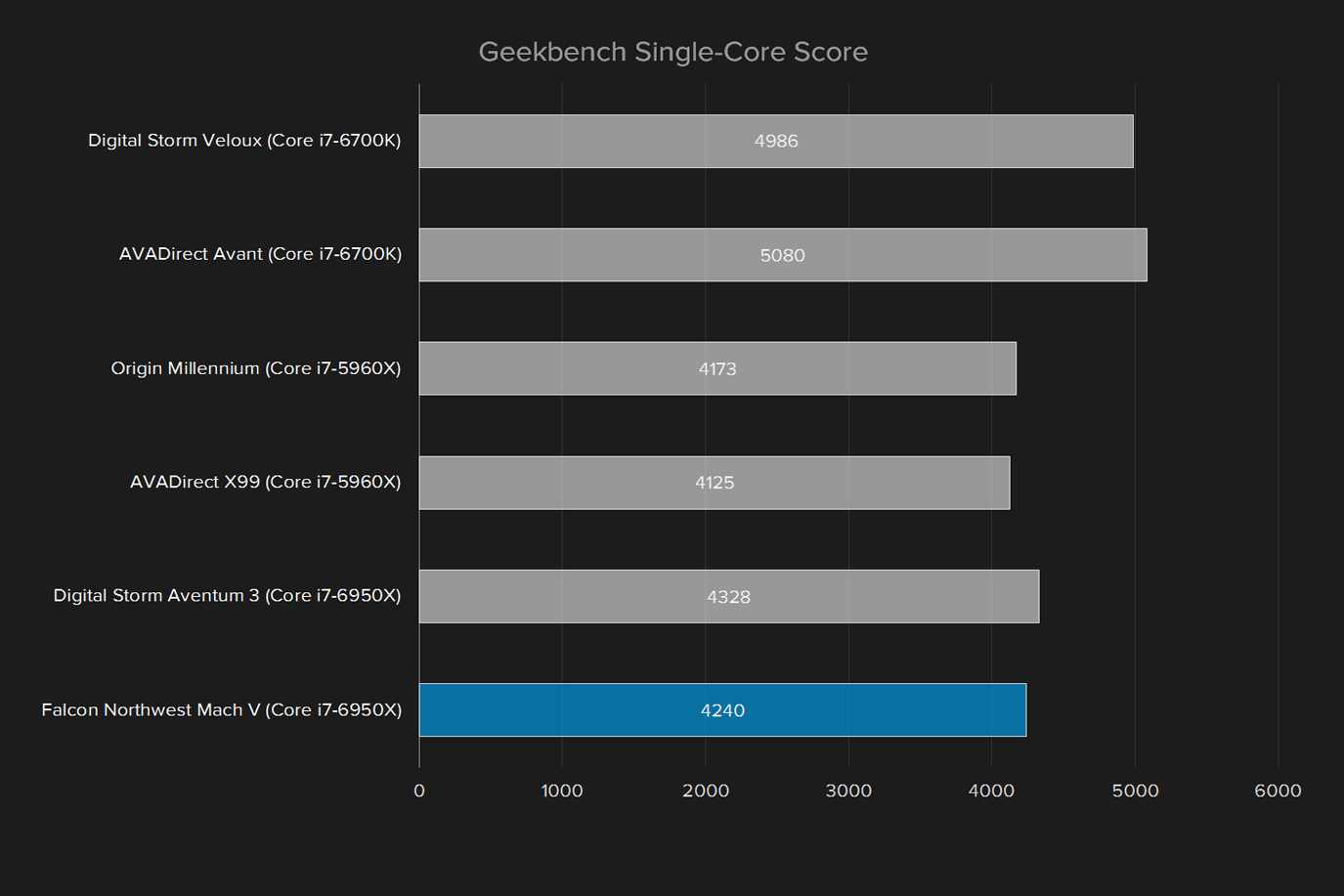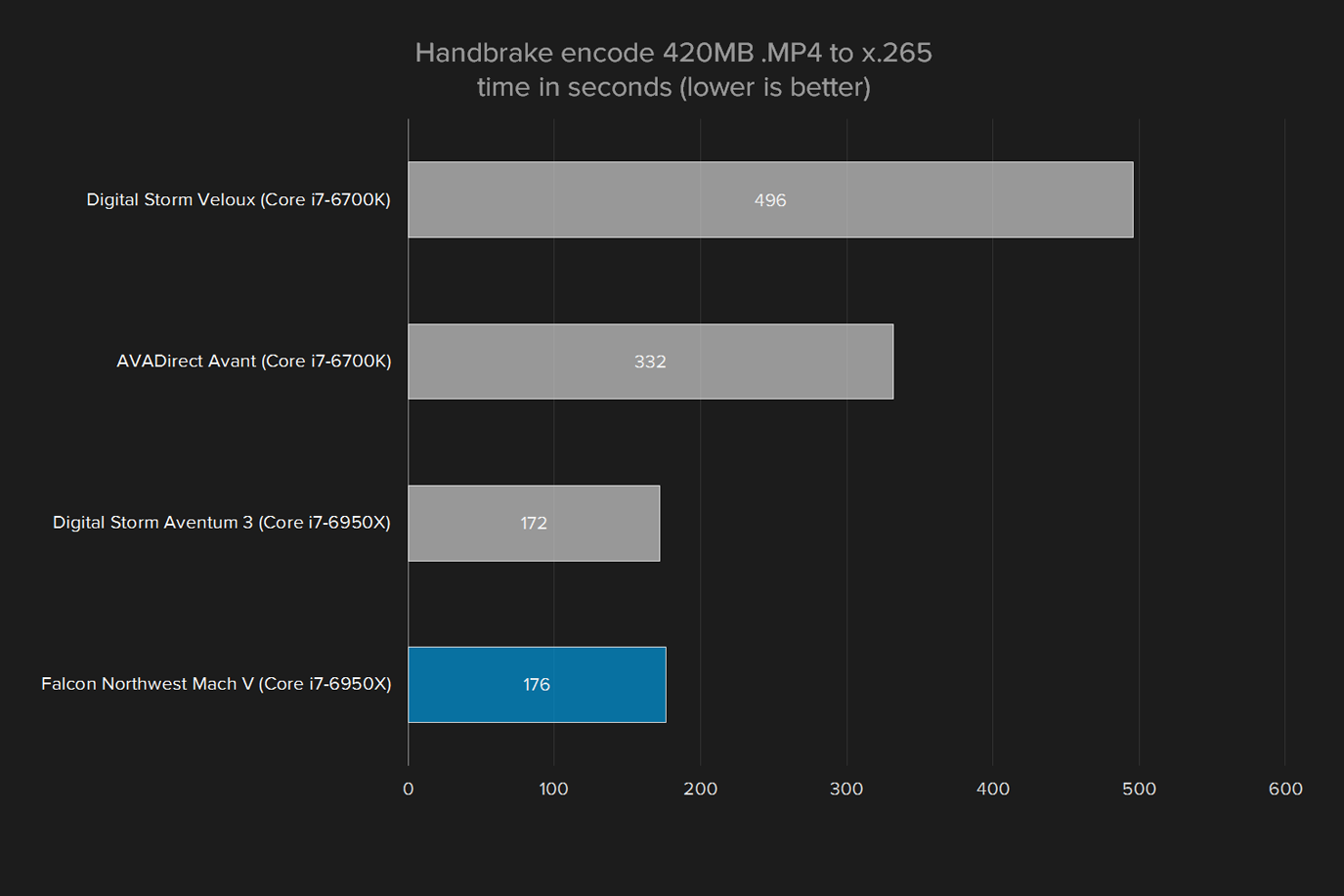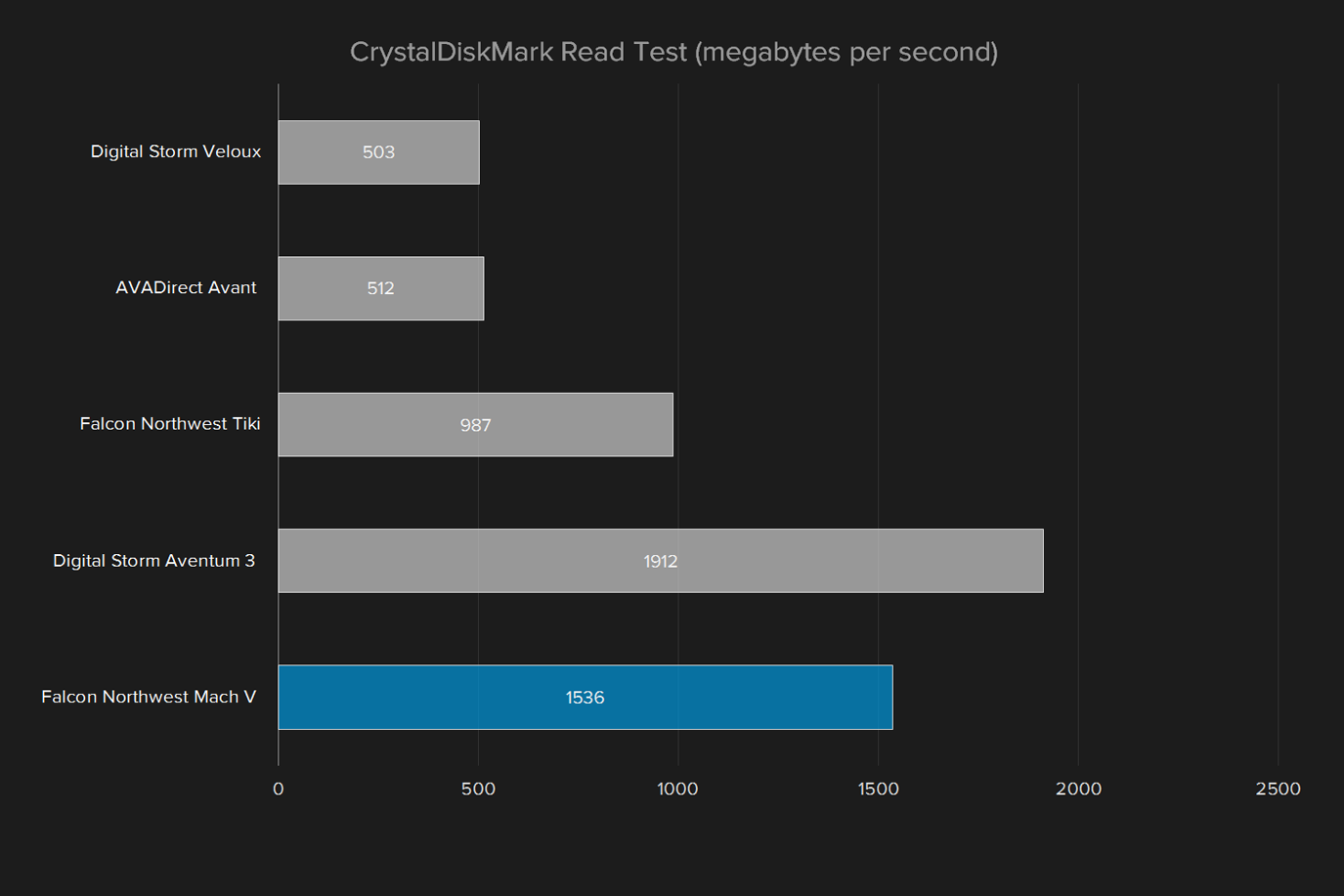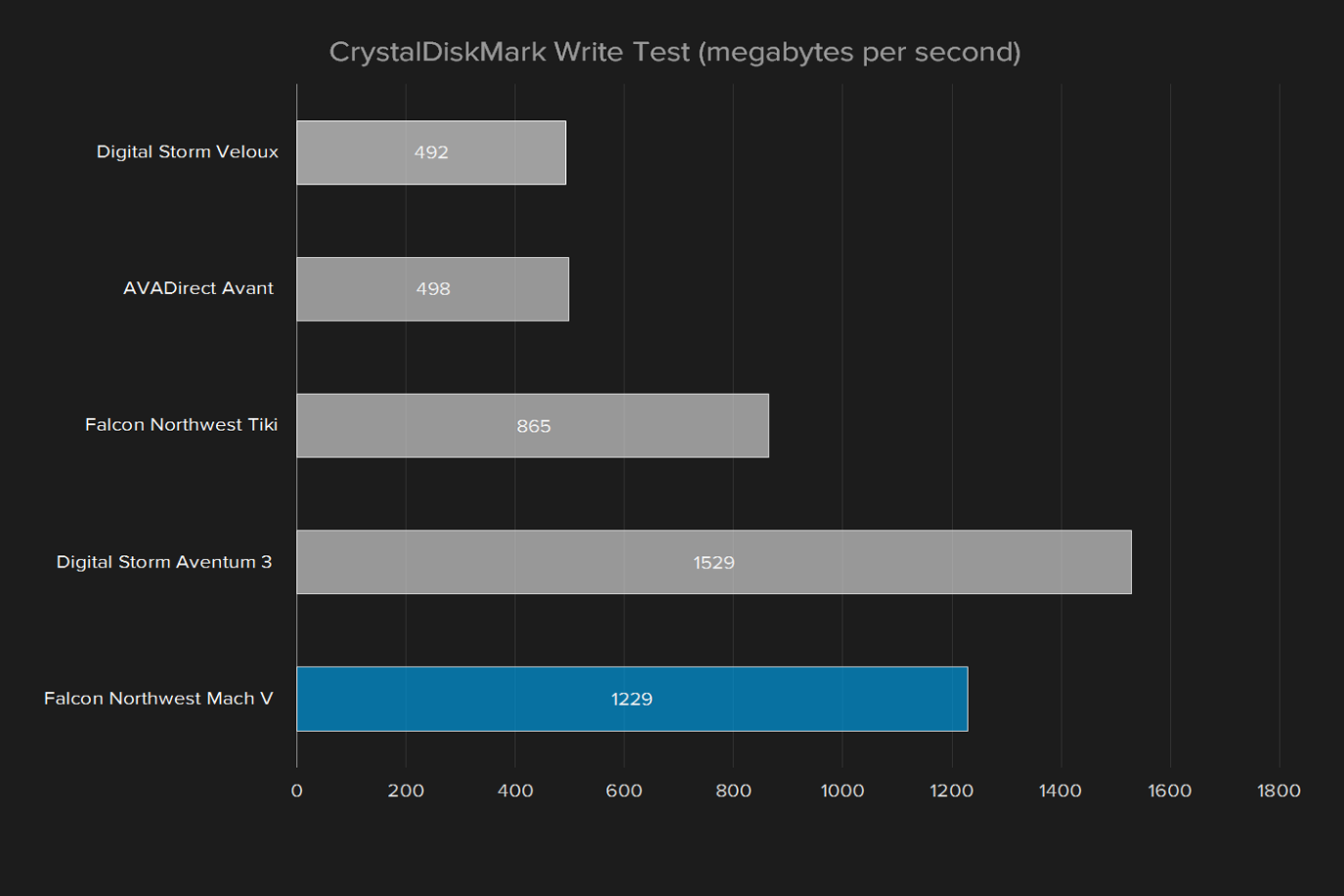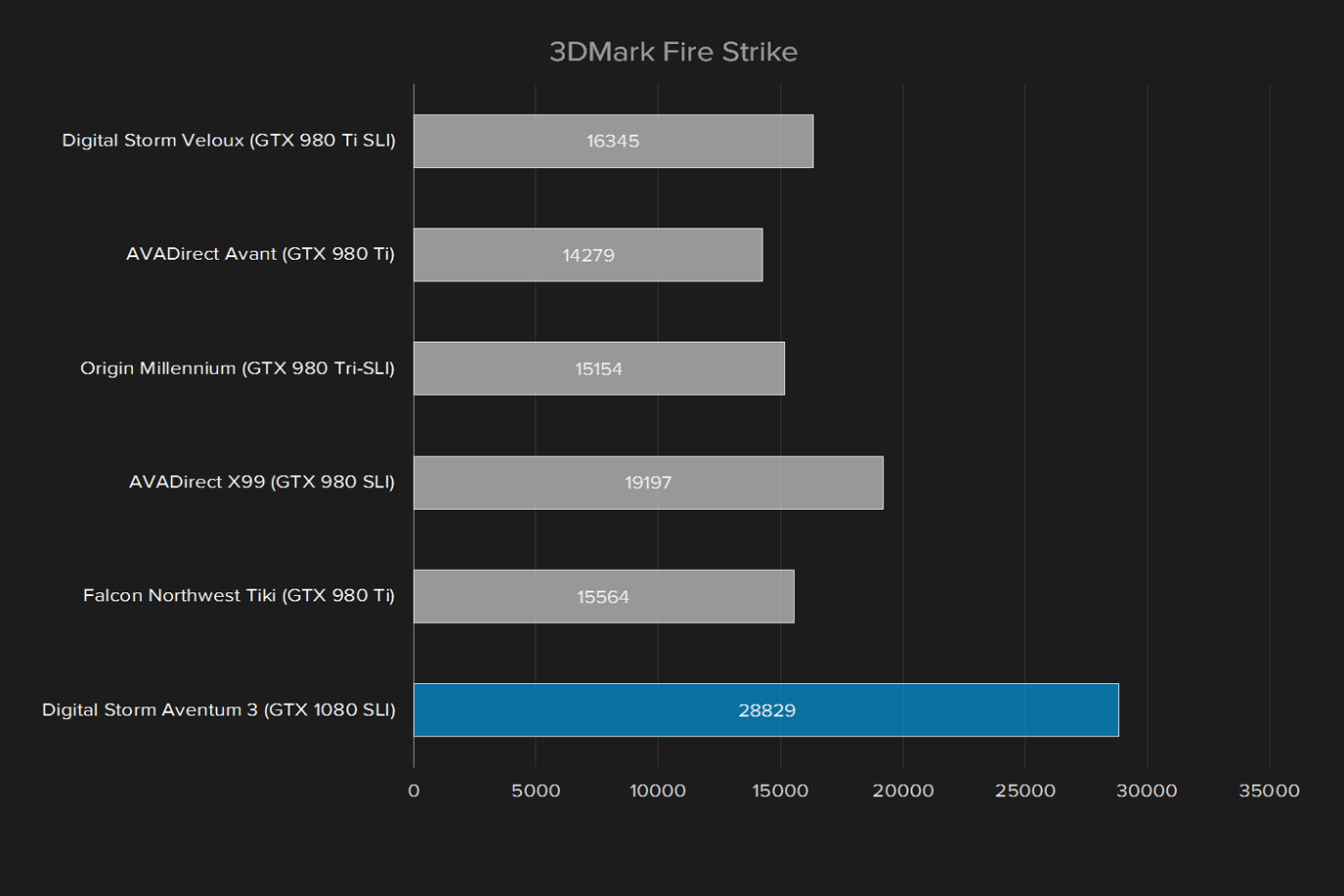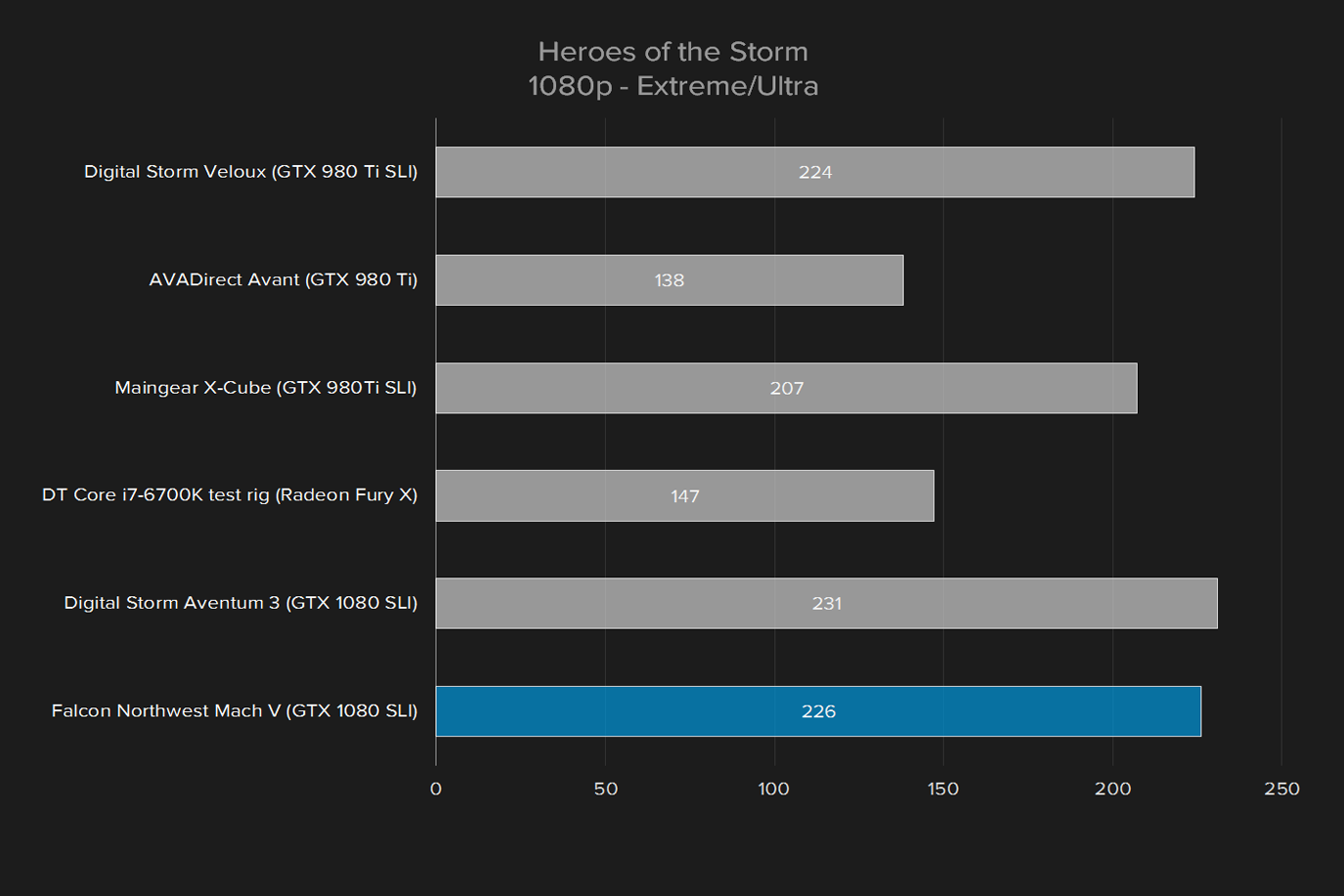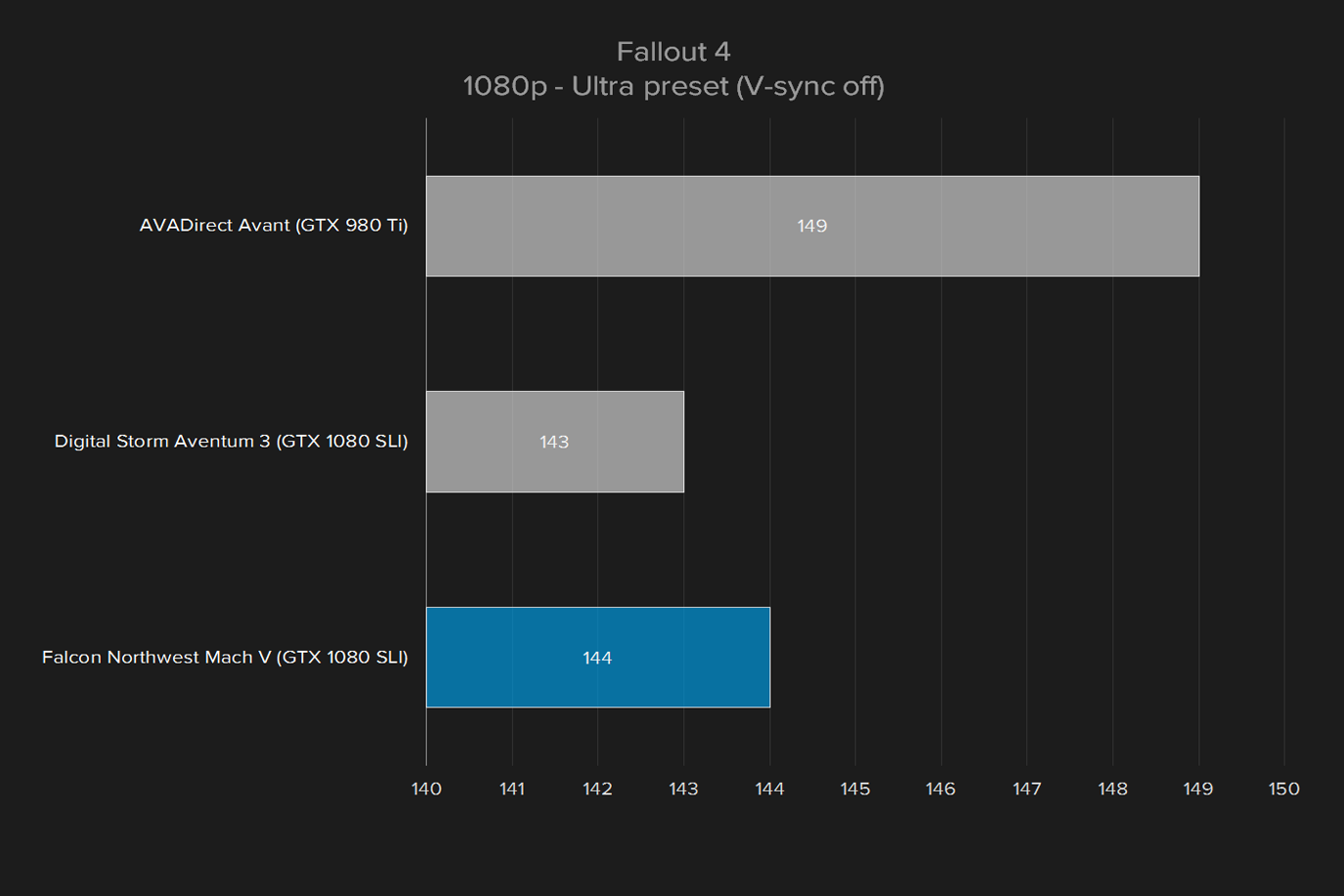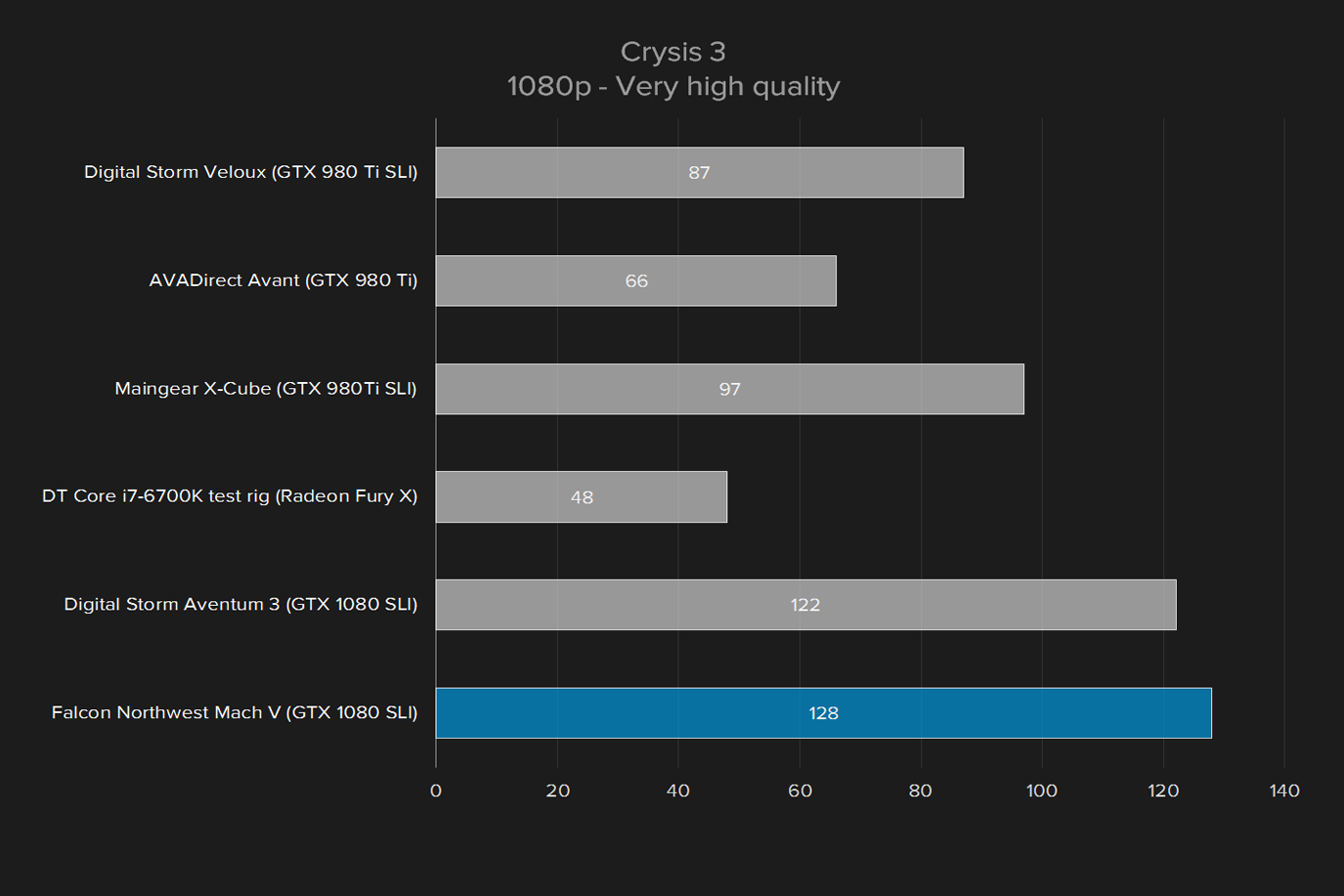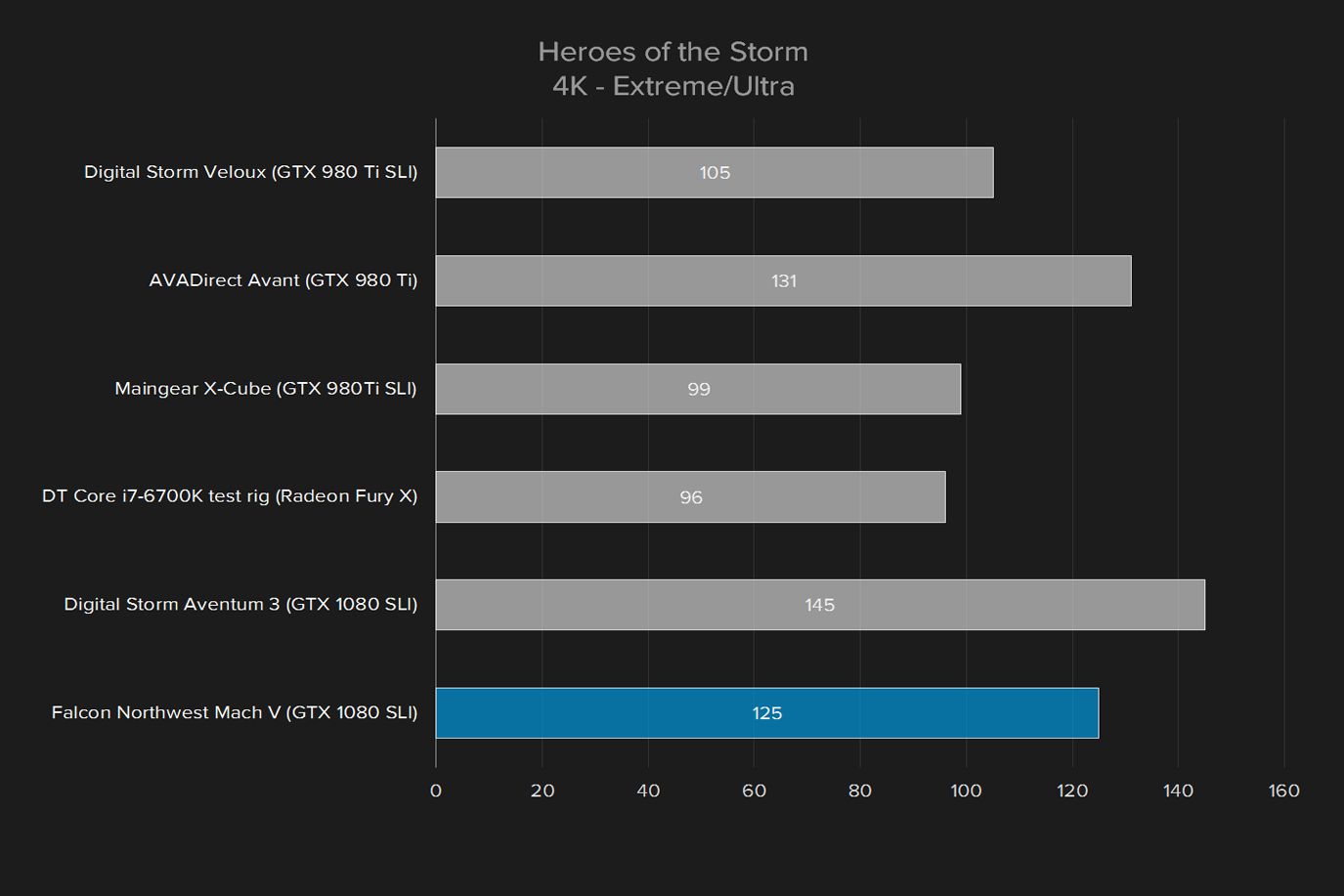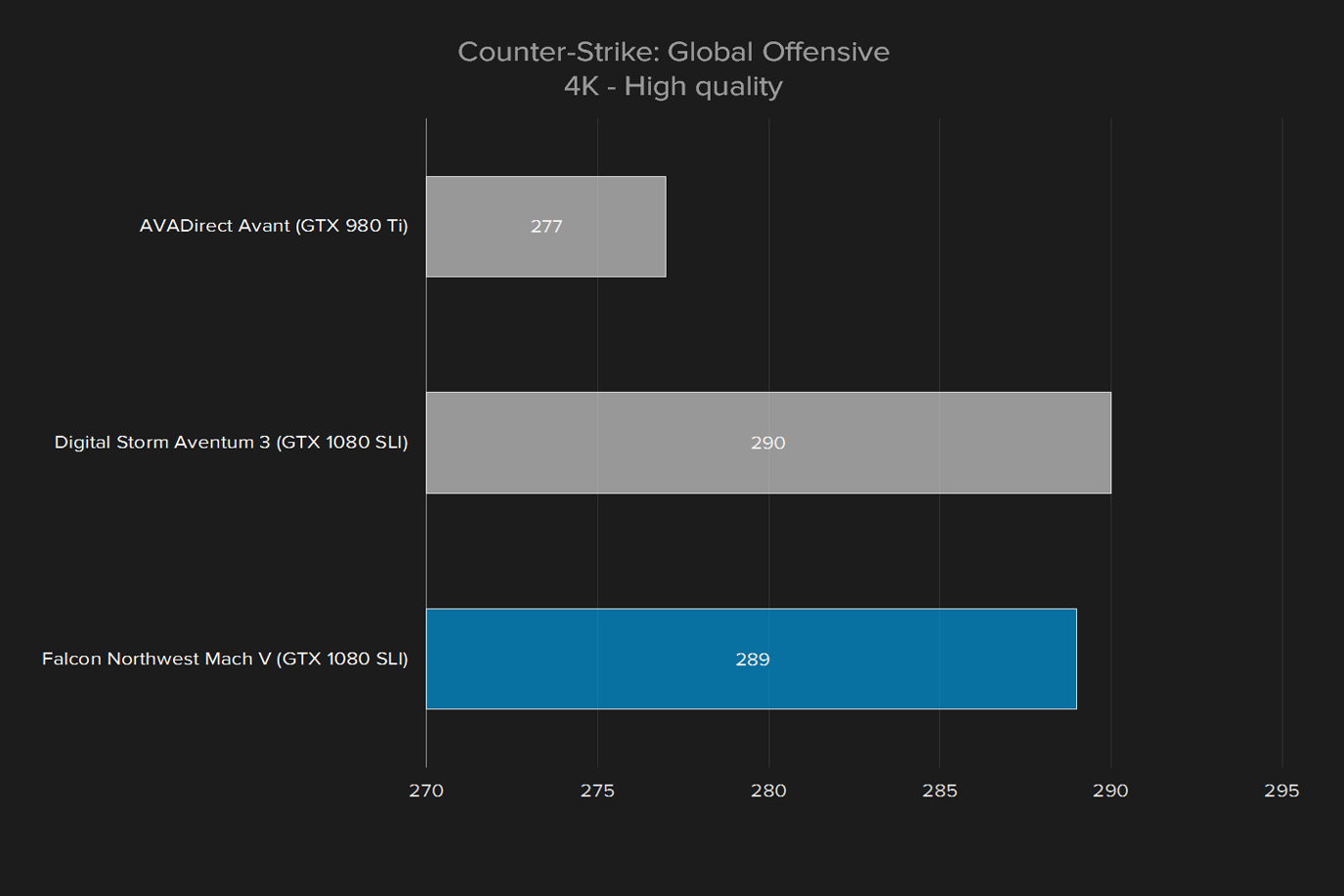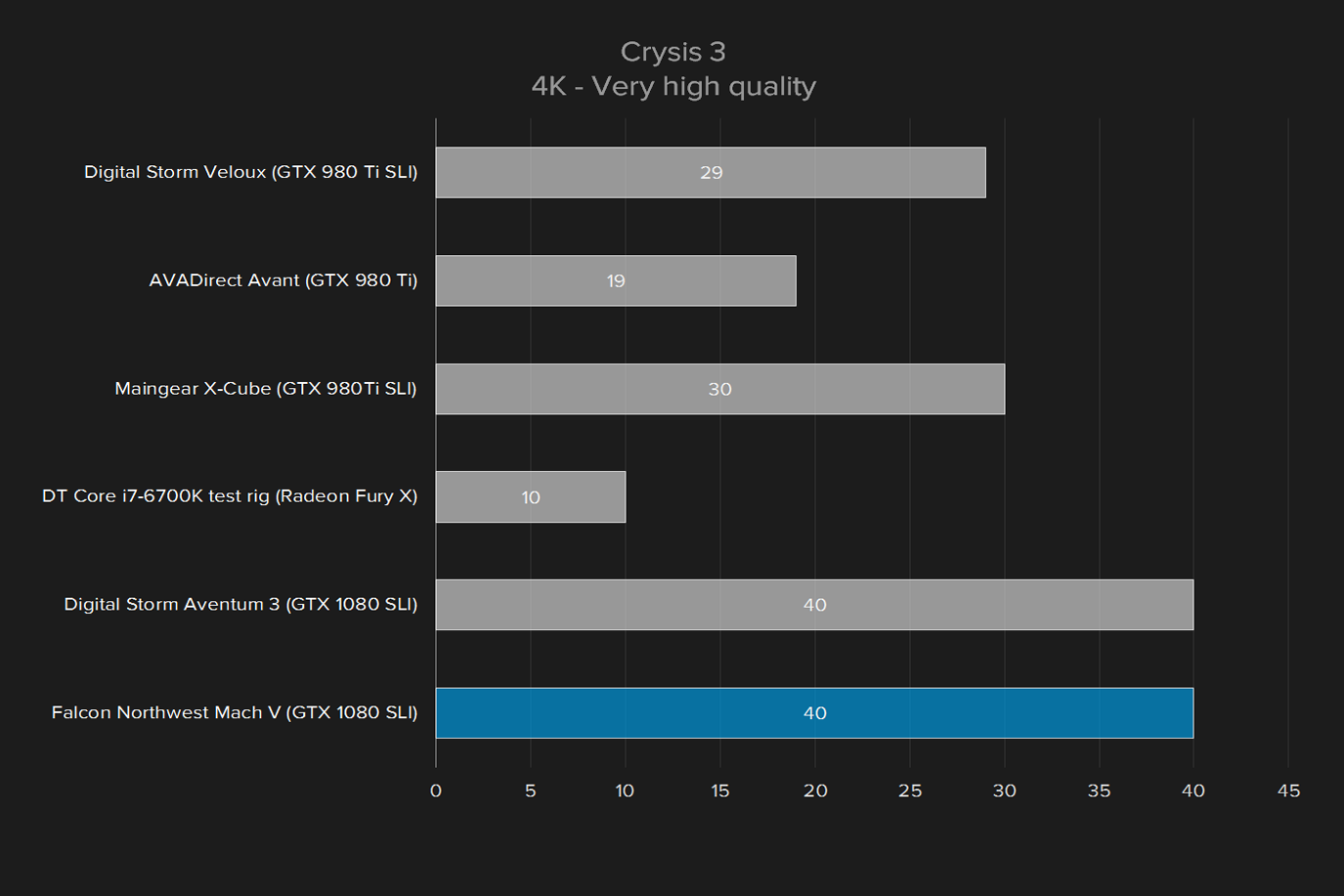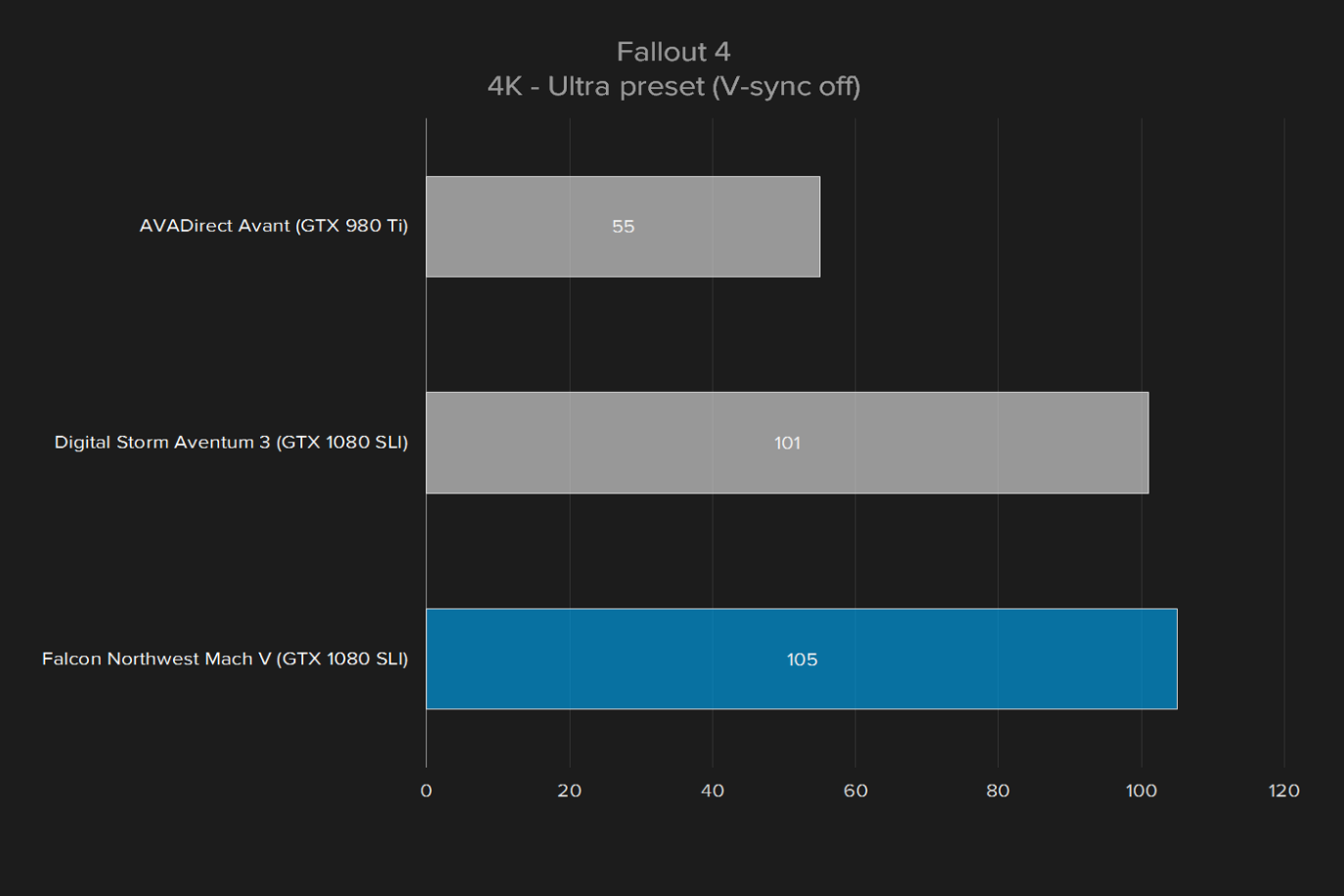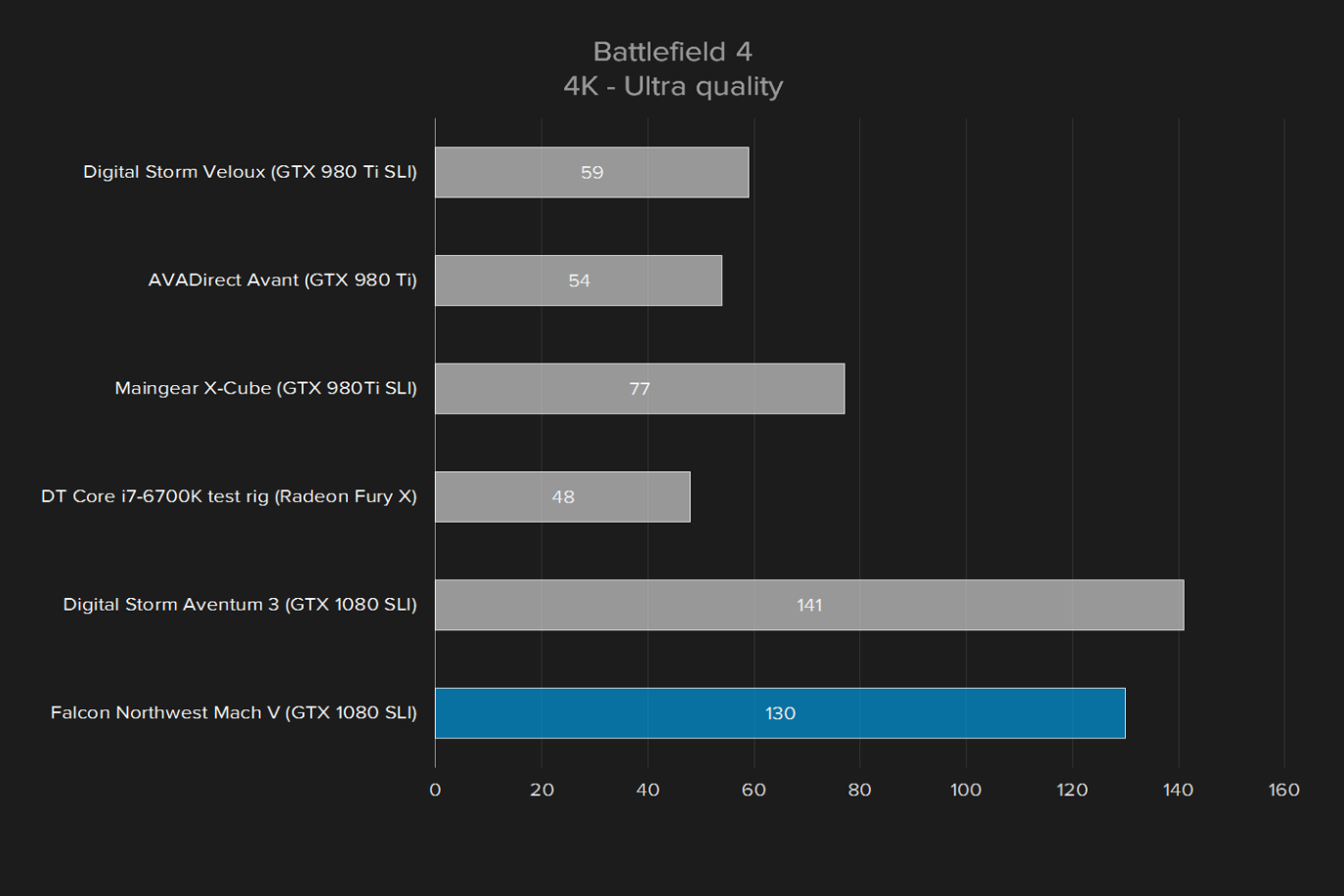- Refined, elegant enclosure
- Easy to upgrade
- Excellent performance in all areas
- Runs quiet
- Class-leading standard warranty
- Exterior can look a bit mundane
- Not as customizable as some competitors
Falcon Northwest’s Mach V is the grizzled veteran in today’s line-up of boutique, high-end custom PCs. First built in 1993, the system has been a mainstay for over two decades. Thresh, one of the world’s first professional gamers, won a $10,000 Falcon Northwest Mach V at a Doom tournament – in 1997.
Though the Mach V name is old, Falcon Northwest is always quick to update it when new hardware comes around. Our review unit proves that. It has Intel’s new Core i7-6950X ten-core processor – overclocked to 4.3GHz, of course – as well as two GTX 1080 video cards. The hard drive is the PCI Express version of Intel’s 1.2TB 750 Series SSD. And, as icing on the cake, Falcon has supplied 128GB of DDR4 2,400MHz memory.
And Falcon didn’t just show off with internals. As you’ve probably noticed, it shipped us a unit with a custom “DT Blue” paintjob, with the Digital Trends logo on both sides.
Of course, that ran up the price. Falcon Northwest’s official quote is $8,787, almost $200 more than already shocking Digital Storm Aventum 3. So, is the Mach V a savvy and experienced leader of the PC gaming world? Or is it an old man screaming at the neighborhood rascals to get off its lawn?
In its golden years
The Mach V’s experience is embodied in its design, which is undoubtedly the most mature sold by any PC maker. Constructed from solid metal panels on all sides, and lacking aesthetic flair like LED interior lighting, or even a case window, it’s a sturdy and reserved rig.
This subtle tact is divisive. Placed next to the Digital Storm Aventum 3, or Origin Millennium, the Mach V can look bland – even with the bright blue paint that spiced up our test system. On the other hand, Falcon’s desktop doesn’t need explanation. Whether you know about computers or not is irrelevant. It just looks nice.
Up front, the Mach V has a case door, which hides the optical drive. It’s a quaint feature that the Mach V has offered through multiple iterations, and works well enough to disguise ugly drive faces. The issue, then, is that it can easily be caught on nearby obstructions (or tall carpet). Given the optical drive has nearly departed from this world, it may be time to ditch the door and move the optical slots to a more out-of-the-way location.
The Mach V’s enclosure remains among the best in the business.
The rig’s rear is more modern. Falcon has tilted the motherboard 90 degrees clockwise, placing the I/O panel on the system’s top instead of the back. A removable, vented cover protects the ports. Owners have the option of either routing cables through a cable catch, or removing the cover entirely for quicker, easier access. This makes the Mach V versatile. It works equally well no matter if it’s placed on top of, under, to the left, or to the right of your desk.
It’s good the rear ports are accessible, as the front connectivity is mundane. There are two USB 3.0 ports, a headphone jack, and a microphone jack. That’s similar to most competitors but some, most notably Origin’s Millennium, offer four front-facing USB ports and, in some cases, physical fan speed or LED case light controls.
Simple means easy
Opening the Mach V couldn’t be easier. The top I/O panel must first be removed, which may mean taking out two screws – however, we think most users won’t replace them once removed because gravity does the job of keeping this panel in place. With that out of the way, both side panels fall away with the flick over a lever, and can be re-attached just as easily.
As mentioned, the Falcon Northwest builds this rig with the motherboard rotated 90 degrees so that the I/O panel faces upwards, but that’s the only unconventional design trait. Everything else is exactly as we’d expect. That’s good. If you’ve ever upgraded or built a PC you’ll be instantly familiar here. And if you haven’t, any guide you find online should be relevant to the Mach V.
Replacing or adding components is simple. The only interior obstruction is a metal airflow guide that separates video cards from the processor. It’s easy to remove and, once out of the way, you’ll have easily access to all video cards, the RAM, the processor, and the motherboard. In our test rig, which had a CPU liquid cooler and 128GB of RAM, the upper-most memory stick conflicted slightly with the CPU radiator, meaning the radiator would have to be removed to replace it. But that’s an extreme situation. Most rigs won’t have nearly as much
Six hard drive bays are included. All of them feature tool-less design, and all of them work with either a 3.5-inch or 2.5-inch drive. There are also four 5.25-inch bays for optical drives and, amusingly, a 3.5-inch external slot, in case you have a floppy drive laying around. All of the bays can be accessed without removing other components. The hard drive bays face outward, and the 5.25-inch bays have several inches of spare space behind them for cable runs.
Falcon Northwest has used the Mach V’s enclosure for years. Yet it remains one of the better cases we’ve seen. It doesn’t offer the extreme level of customization of the Origin Millennium, or the impressive size of Digital Storm’s Aventum. But it is spacious, logically arranged, and only occasionally asks owners to break out a screwdriver.
The world’s quickest processor doesn’t disappoint
Falcon Northwest’s Mach V is the second system we’ve reviewed with Intel’s Core i7-6950X, the company’s latest 10-core behemoth. The Digital Storm Aventum 3 was first. And like the Aventum 3, the Mach V is overclocked to 4.3GHz, an increase of 1.3GHz over the processor’s base clock speed of 3GHz. Does that mean the Digital Storm and Falcon systems perform identically?
Yes, it does.
The Aventum 3 broke all of our benchmark records, becoming the first system we’ve reviewed to score over 40,000 in GeekBench, over 60,000 in 7-Zip, and the first to encode our 4K test trailer to h.265 in under three minutes.
The Mach V follows in the Digital Storm’s footsteps every step of the way. While Falcon’s system is technically, slightly slower in every processor benchmark, the difference is literally fractions of a percentage point. The two systems are tied for all meaningful purposes. Which makes sense given they have identical processors, clocked at the same speed.
That shouldn’t take away from the Mach V’s incredible speed. Tying for the top spot means this rig beats our previous record holder by 25 percent in Geekbench’s multi-core test, and doubles the typical score of an overclocked Intel Core i7-6700K. If you need performance, the Mach V with a Core i7-6950X can deliver.
Intel’s 750 Series delivers
Falcon again turns to Intel for the Mach V’s primary hard drive, choosing Intel’s Series 750 PCI Express drive. This cutting-edge hardware crams 1.2TB into a PCI slot. The result is outstanding performance.
It’s interesting to see how the Intel Series 750 drive performs in our tests compared to the Samsung 950 Pro, which is represented by Digital Storm’s Aventum 3.
The Samsung-powered Aventum outperformed the Intel-powered Mach V in CrystalDiskMark, which performs a series of sequential tests over a short period of time. But HDTune, which runs a test over the course of several minutes, came out substantially in favor of the Intel drive. The performance graph put out by HD Tune suggest the Intel 750 Series handles sustained read operations better than the Samsung 950 Pro.
Speed aside, the Intel Series 750 PCIe drive is notable for its size. At 1.2TB, its capacity far exceeds other drives that deliver cutting-edge performance. Samsung’s 950 Pro, for example, offers no more than 512GB on a single drive.
Of course, virtually all of the Mach V’s competitors offer the Intel Series 750 1.2TB as an option, though none have been so bold as to actually send us a system with it. It’s generally priced at $1,000. The Samsung 950 Pro 512GB is just $320.
Twin GTX 1080s can conquer 4K
Nvidia’s GTX 1080 is the new king of gaming performance, so it’s no surprise to see two of them lined up inside the Falcon Northwest Mach V. There’s no better choice for top-tier gaming performance. With that said, Falcon’s system does differ from the Digital Storm Aventum 3 we tested in one critical aspect – the Falcon’s weren’t overclocked, and weren’t liquid cooled. Does that make a difference?
No, it doesn’t. The Mach V and Aventum 3 trade blows at both 1080 and 4K resolution, which isn’t surprising given their many similarities. In some cases, the Mach V wins by a few frames per second. In others, the Aventum 3 takes the crown. The margin of victory is never large enough to be important.
Both computers crush 1080p, the most common gaming resolution. Many games in our test bench, including Battlefield 4, bounce off in-engine framerate caps even with every detail turned on.
4K is more of a challenge, and gives justification for the Mach V’s incredible hardware. Like the Aventum 3 before it, the Mach V can produce more than 100 frames per second in most modern games even with resolution at 3,840 x 2,160 and maximum or near-maximum detail. Crysis 3 is the only title that does not exceed 60 FPS, but even it is at least enjoyable, averaging 40 FPS.
The Falcon Northwest Mach V represents the cutting edge of what’s possible with today’s gaming hardware. It’s overkill for most gamers. There’s no reason for someone with a 1080p monitor to drop over $8,000 for our top-tier review unit. If you game at 4K, though, you do need a system this quick to achieve a minimum of 60 FPS in modern titles.
A desktop you can live with
The Mach V’s elegant style isn’t just for looks. It represents the company’s entire approach to system building. The missing case window and small cooling vents are meant to minimize noise. Sound dampening foam, a standard feature, further quiets the case.
These efforts are successful. The Mach V put out 37.5 decibels at idle, three decibels less than the Digital Storm Aventum 3. At load, the Falcon puts out 44.2 decibels, which is four less than the Aventum 3. The Mach V’s load result also beats the Cybertron PC Thallium, Maingear X-Cube, and iBuyPower Revolt 2. The only dedicated gaming desktop we’ve reviewed that significantly defeats the Mach V is Origin’s Millennium, which produced 39.6 decibels. But that rig had a quad-core Intel processor and one video card.
We don’t think anyone will be annoyed by the noise this Falcon puts out. While it is audible in a quiet room, the character of the noise was silky-smooth, with no shrill peaks or harsh buzzes. It’s easy to ignore – as it should be.
A warranty that has your back
Falcon ships every Mach V with a three-year parts and labor warranty. The company also covers the cost of overnight shipping for the first year (after that, the customer has to pay).
Falcon’s warranty terms are superior to all its competitors.
These terms are superior to all of Falcon’s competitors, and sometimes significantly so. Origin, for example, does not include a standard three-year warranty with any of its systems. Digital Storm claims to have a standard three-year warranty, but it only covers parts for one year.
The shipping terms deserve particular note. Origin’s base warranty only covers shipping for 45 days. Digital Storm’s warranty covers shipping for 60 days. Falcon has trumped its competition here, ensuring that owners have not just one year of free shipping, but a year of overnight shipping – which is infinitely more convenient.
Conclusion
The Falcon Northwest Mach V we received is very near the most extravagant example of the breed. It arrived not only with a custom paint job, but also a ten-core Intel Core i7-6950X processor, twin GTX 1080s, 128GB of memory, and a 1.2TB solid state drive. It’s no surprise that all this rang up to $8,787, almost $200 more than Digital Storm Aventum 3 we just reviewed – and that rig had a full liquid cooling loop. As we tested it, the Mach V is among the most expensive desktops available.
You may think the Mach V a poor value. In fact, it’s competitive – when equipped with more reasonable specifications. Downgrading the RAM to 32GB, switching the solid state drive to Samsung’s popular 950 Pro 512GB, and ditching the paint, lowers the price to $6,261. None of those changes impact gaming or processor performance.
The Origin Millennium is more expensive when similarly equipped, ringing up at $6,360. That’s without the three-year warranty that comes standard on the Mach V. Digital Storm’s Aventum 3 rings up at about $6,150 with the same hardware, though again with a less impressive warranty. Other competitors hover around the $6,000 to $6,400 range, putting the Mach V in the middle of the pack.
The Mach V is not the most attractive rig in the boutique desktop space, and it doesn’t offer glamorous additions like full liquid cooling and LED lighting. Instead, Falcon is betting that its years of experience, and mature design, will win over buyers. It has, at least, won over us. The Mach V’s excellent performance, quiet operation, and easy upgradability are always winning traits in this arena, and the inclusion of a best-in-class standard warranty edges the system towards top honors. If you have a few grand to drop on a gaming desktop, it should be a Mach V.







